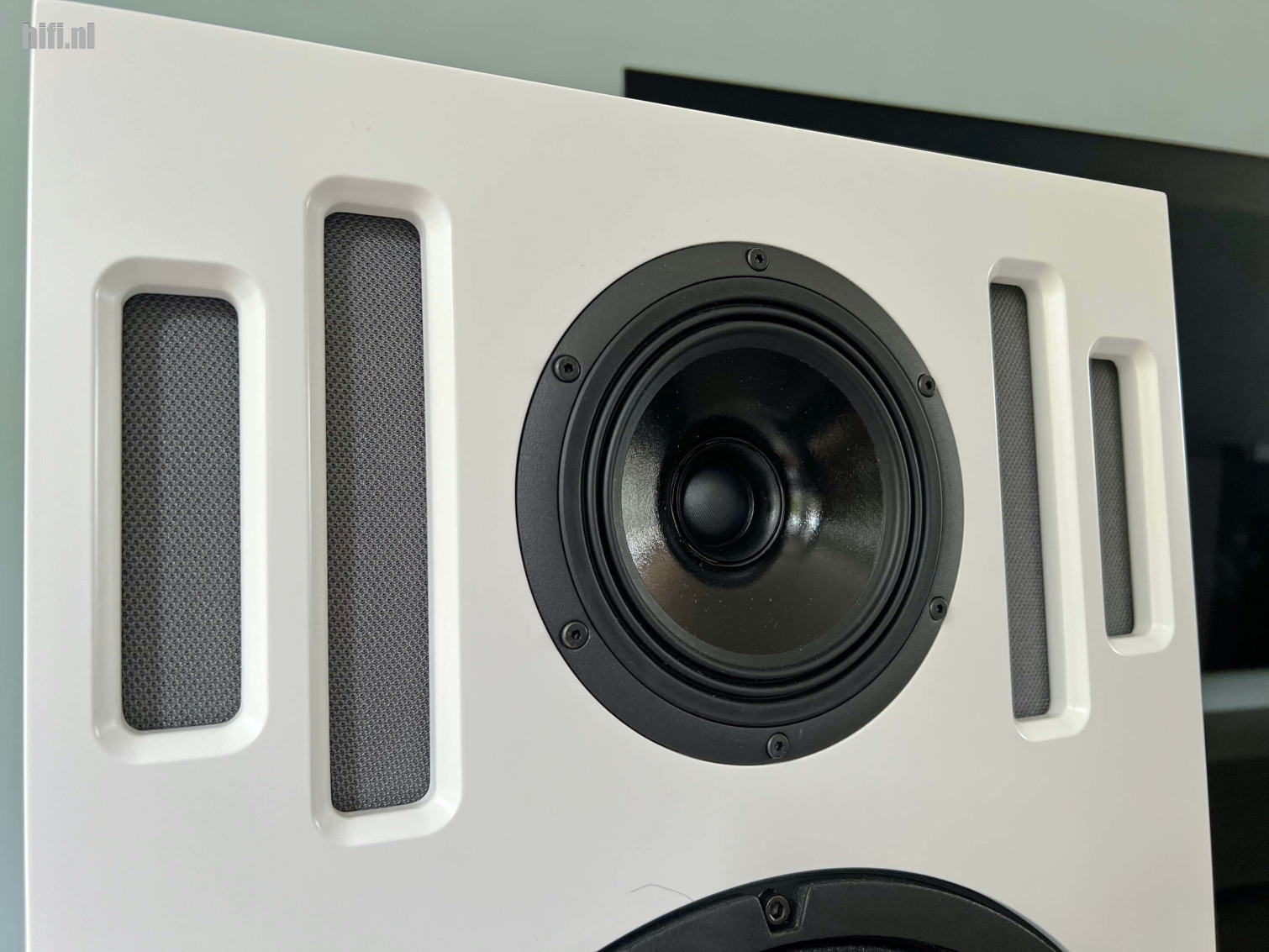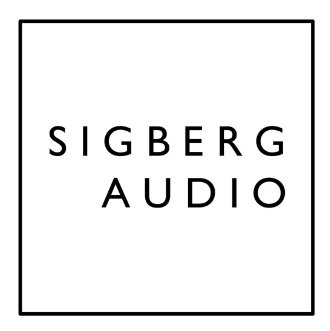
Earlier this year Norwegian manufacturer Sigberg Audio sent us a set of two Norwegian produced Manta loudspeakers. Also included were two Sigberg 10D subwoofers to achieve a full range sound experience. This is probably one of the first, if not the first review of this active cardioid loudspeaker system in the EU. Sigberg only mentioned "I'm curious to know what you think of it." And yes, I am quite curious to be honest. | Voor Nederlands, klik hier
Active loudspeakers are becoming more and more mainstream in higher-end audio. For decades they've already been the loudspeaker of choice for many professionals in the recording industry. Despite the popularity in the earliest stage of music production, many audiophiles however view these amazing pieces of gear all too often with suspicion. After all, hi-fi speakers with built-in amplifiers are not audiophile, right? All should be passive and preferably as analog as possible in order to deliver an audiophile experience – right? That’s where I mostly disagree and these active three-way Sigberg Manta cardioid loudspeakers clearly underpin my personal opinion on that. Honestly, I’m not stating this in order to prevent Thorbjørn from directing the wrath of all gods from Norse mythology at me, but I strongly believe that an active driven loudspeaker makes the best match between amplifier and drivers. Moreover, thanks to DSP you can optimally tune it to its cabinet design.
Yes, I do agree it is more difficult to achieve a full-range music experience from conventionally designed passive loudspeakers with oversized speaker cabinets without DSP or tone control. It shows real craftsmanship to achieve and it requires extensive acoustic knowledge, a particulate skillset and loads of spending capital. To apply a certain amount of technology at least makes it a lot easier for the manufacturer, easier to implement in most situations thanks to the smaller form factor and its easier budget-wise. Most importantly it allows a broader group of music lovers to actually afford top performing loudspeakers.
Honestly though, what is more important to you: a traditional passive design without technology involved, or is it all about the music experience regardless of the technology involved? For me personally, it’s the latter. I strongly believe it’s all about experience. Not solely by listening to super-deluxe produced albums or first pressings, but also with regular metal, rock and dance albums with a lesser sound quality. Like most of my albums.
Sigberg Audio Manta
Sigberg Audio is not the sole manufacturer developing active driven cardioid loudspeakers. There is a growing number of manufacturers that are choosing the active path, sometimes they also opt for a digitally produced cardioid beam pattern using additional drivers for this purpose. Sigberg, however, is positioning itself in a unique space with its Manta series. Besides the use of the Dutch originated Hypex class-D modules for amplification and DSP, the manufacturer uses as little complex technology as possible to generate such a cardioid pattern. Sigberg Audio instead uses acoustic cleverness such as “cutting up” its acoustic challenges into smaller pieces. In order to perform best in corners or close to a wall, the manufacturer (a) uses a vented cabinet design that generates such a cardioid dispersion avoiding adverse reflections and (b) filtered out signals below 80 hertz, so deeper bass frequencies longer cause trouble when placed in lesser performing spots.
Contrary to additional electronics and multiple drivers in flanks or rear of the cabinet to generate that desired kidney-shaped pattern, Manta cabinets are fitted with “breathing” slots in the bass and the midrange compartments. You will notice some parallels to the so-called open baffle designs that are characterized by an uncolored and “cabinet-less” music reproduction. Thorbjørn's vented cabinet design adds openness in music and drastically improves imaging properties. Regardless of its placement in the room.
Ultimately, a subwoofer supplements the bottom end in the frequency spectrum. You simply put the subwoofer anywhere you like and adjust the gain for a well-balanced sound. Done right, it will not colour or thicken the sound. It simply disappears and will just make itself heard when the music demands it.
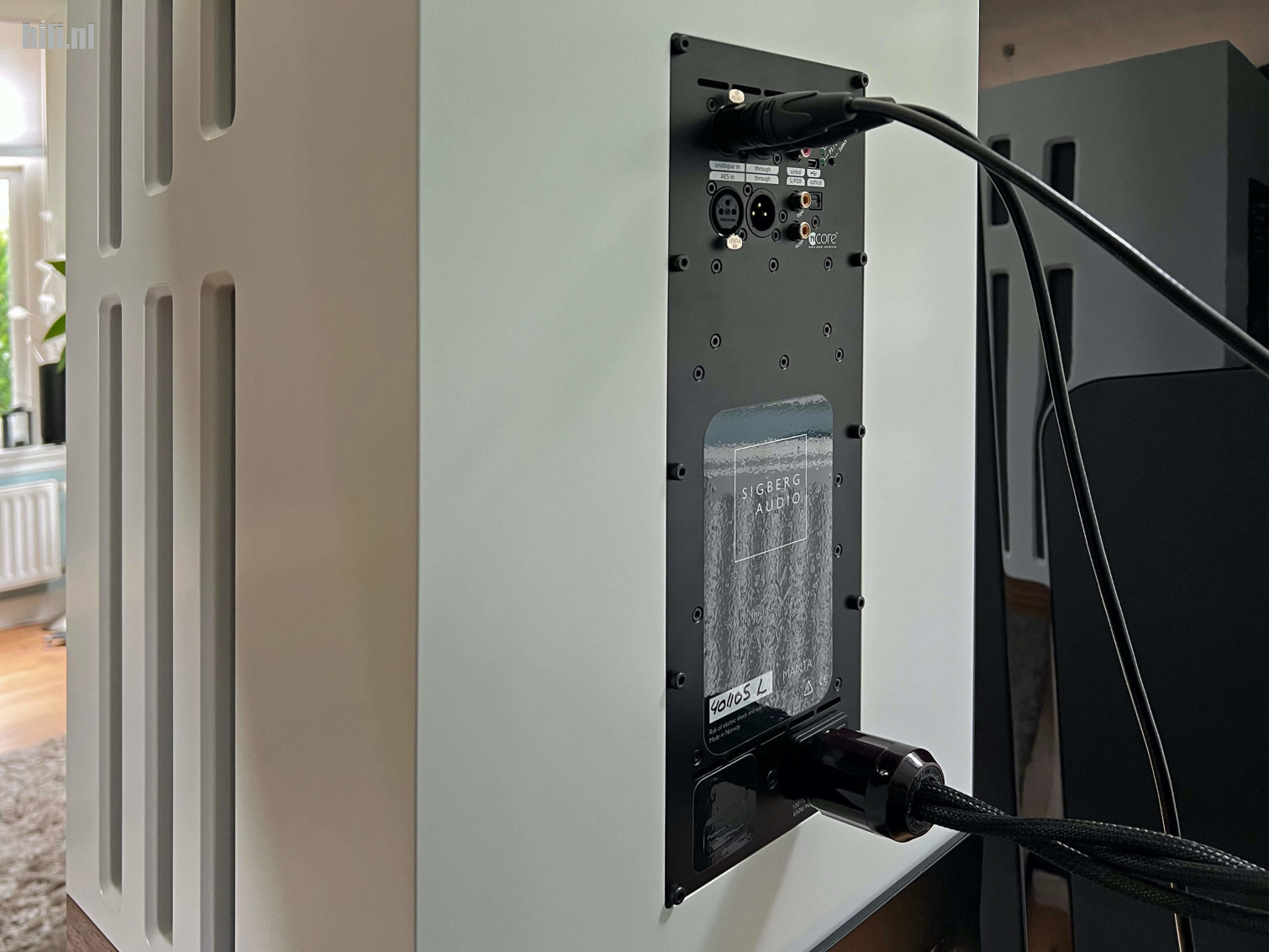
Sigberg Manta loudspeakers measure 360 x 600 x 350 mm and put a staggering weigh in the scales of 25 kilograms per loudspeaker. These three-way (four-way when including a subwoofer) Mantas feature a 12-inch paper-cone bass driver, a 5.5-inch paper-cone midrange driver and a 1-inch silk dome tweeter. The mid-high section has a coaxial design which carefully aligns the sound beam of the tweeter with the beam of the midrange driver, delivering a most precise timing and phase behavior.
All Sigberg drivers are partly sourced at Danish driver manufacturer Scan Speak and the Italian manufacturer Sica which is a well-known supplier of PA-drivers. High-sensitive, high-performance and light-cone Sica drivers are mounted as matched pairs (with up to 1 dB of mutual difference between 100 and 10,000 hertz).
Cardioid dispersion characteristic (120-180 degrees) of these Manta’s is 10-12 dB between 100-500 hertz, 16-20 dB between 500-1,000 hertz and 25 dB between 1,000-5,000 hertz. Sigberg relies on a 1st/3rd-order linear phase crossover filter. Drivers are individually driven by a 3-channel Hypex nCore amplifier that delivers 600 watts of class D power per channel. This amplifier enables the Manta to deliver a stunning sound pressure of 122dB at a distance of 1 meter and a total harmonic distortion of less than 0.5% at 96dB. You can also make use of a parametric 9-band equalizer with which you can make minor corrections to the factory settings for the benefit of placement, space or personal taste. Which I did not apply during the time these speakers were visiting.
Manta’s monitors can analogue connected with both RCA or XLR interconnects. The signal is then passed-through to a second set of connections allowing you to connect an additional Sigberg 10D or another subwoofer of your choice. Digitally, both speakers are fitted with an optical Toslink, coaxial S/PDIF and balanced AES-EBU input. These digital inputs are also passed-through for use with a digitally driven subwoofer. Latency? 0.35 ms analog and 1.8 ms digital. You can select both analog and digital inputs manually on the rear panel, or make use of the automatic signal detection that is cleverly provided.
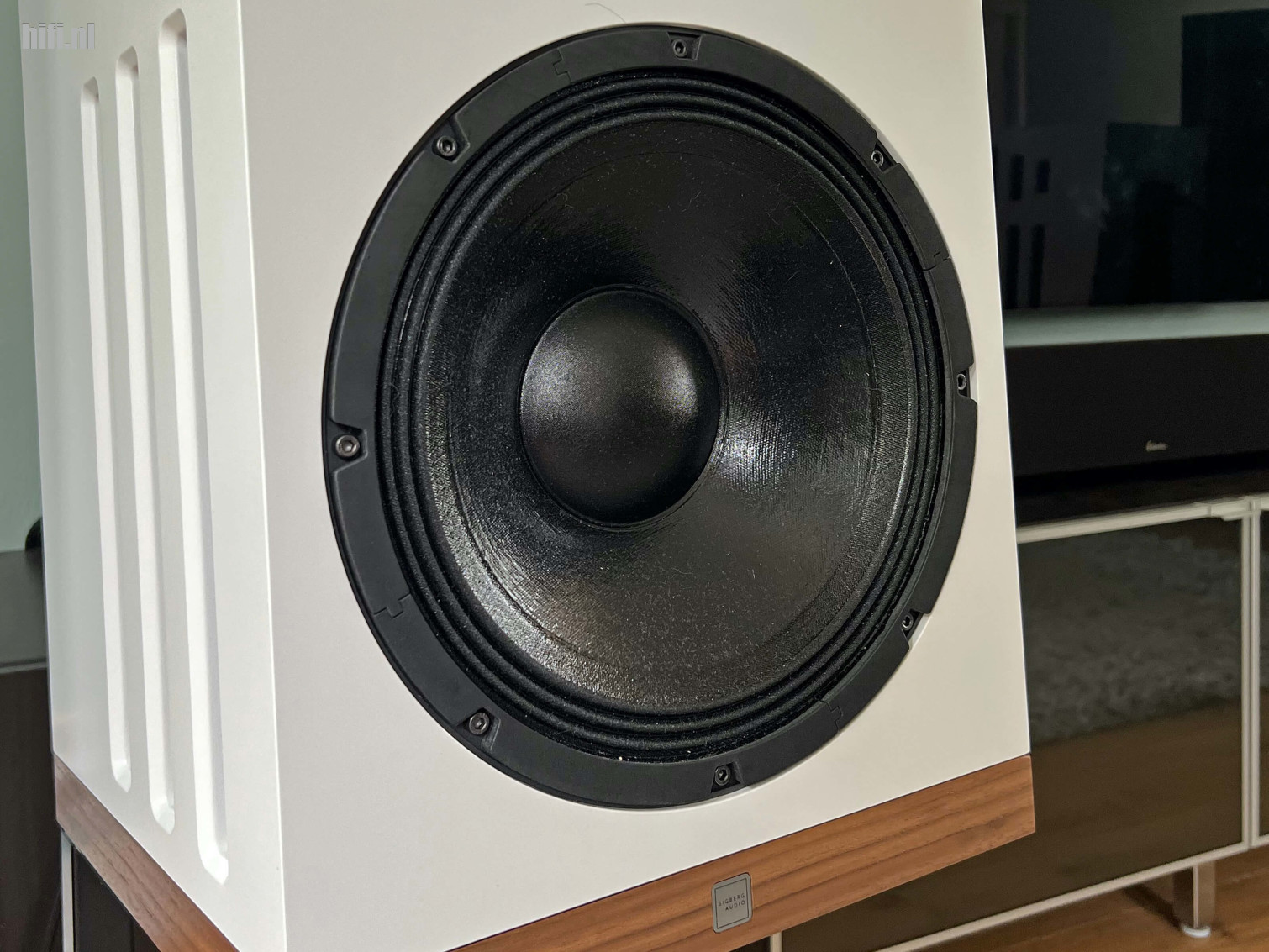
Straight from the factory the speakers come with a power cord, USB cable and magnetic detachable grills. The manufacturer also supplies a set of solid stands on which the speakers can be placed on ear-height, slightly tilted in a four-degree upward direction. The advised minimum distance from speaker to wall is between 10 and 50 centimeters; I place them slightly toward the listening position standing 2.2 meters apart from each other in front of my television cabinet. The listening position in this review is just under 3 meters, bringing it within the 1.5 to 5 meters as advised by the manufacturer.
Then there are those cute Sigberg 10D sealed enclosure subwoofers. For this review I received the full treatment with not just one but two pristine bass generating cubes that are available in satin white and black. Small sized as they are, they are fitted with two 10-inch woofers and are internally driven by a powerfull Hypex nCore DSP enabled class D amplifier. Frequency response starts at 23 up to 250 hertz. In-room bass extension reaches all the way down to 16 hertz allowing a full range sound spectrum including Sigberg Manta or any other 3rd party monitor. These 10D’s can be driven by RCA, XRL or high-level inputs. Latency is 0.35 ms and there is a variable gain control to create the perfect sound balance to your ears.
For the real nerds I probably should include sound pressure levels, sizes and weight. Here we go; the cabinet measures 36 x 37 x 41 cm, weights the better part of 27 kilograms and produces a whopping 117 decibels at 1 meter and 30-80 hertz. I must say I’m most impressed by the performance of these tiny subs.
Sigberg Manta listening sessions
Sigberg Manta monitors are quickly hooked up to my Bryston BP-26 preamplifier with a set of Grimm TPR XLR interconnects. I also connected both Sigberg Audio 10D subwoofers with a similar set of interconnects to Manta’s XLR-outputs, creating a flexible four-way full-range speaker setup with a frequency span that ranges from 18 hertz up to 20 kilohertz (+/- 3dB). Other than increasing the subwoofer gain half a notch to compensate for the position of the subwoofers in the room, I make no further adjustments to the factory equalization.
The first results are incredible. I instantly experience a full bodied, uncolored sound and, more importantly, a huge sweet spot. Vocals? They sound superb and lively too.
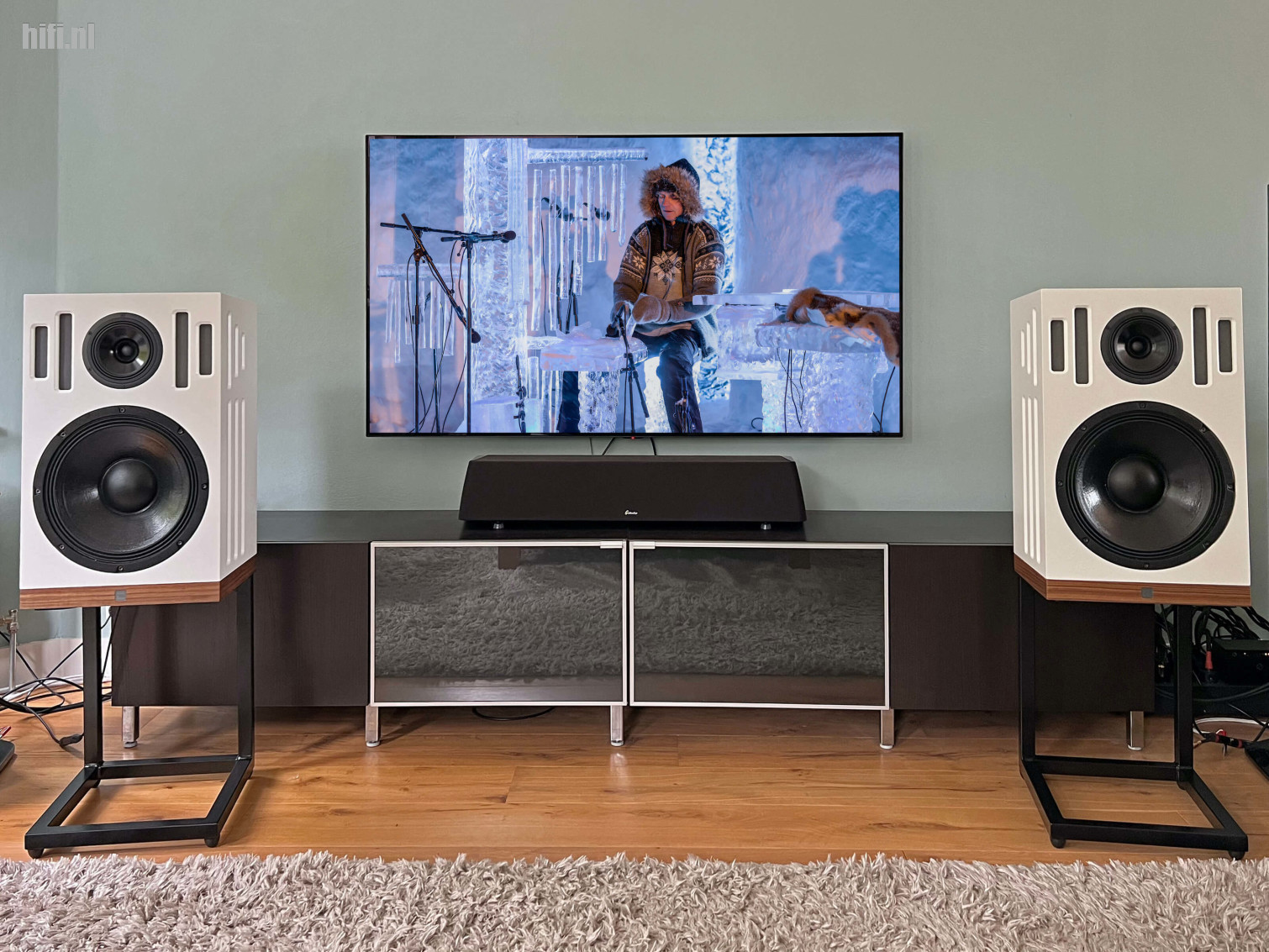
While playing “House of Broken Love” from the album ...Twice Shy by Great White, I experience a tightly defined bass drum which has a nice punch and a deep bass extension to it. This gives the impression of a full-sized percussion in my room. Snare drum sounds neutral, tight with a snappy attack and a long decay by room echo’s pointing out the drummer’s location halfway down the imaginary space. Cymbals are nicely placed at roughly the same distance from the listening position as the percussion itself, adding to the realism.
The song “She Only” starts with an acoustic steel-string guitar that has an authentic sparkling glare to it. More importantly, it is positioned slightly in front of the lead vocals, just where such a guitar would spend most its time when being played. Tambourine is, again, placed halfway down the space allowing me to clearly notice the ringing of individual shells with a high degree of realism. The interplay of lead and backing vocals are adding an extra dimension to this ballad.
Selecting the track “Grace Too” from The Tragically Hip's 1994 album Day for Night, bass drum is rendered with a delicious punch and quite a bit of low-end extension. This shows it’s not so much dependent on the recording, but Manta’s do add a sense of live vibe to it. The raw vocals of Downie, who sadly passed away way too soon, cuts into my soul like a blunt knife. These Sigberg Manta speakers not only present my tracks subtly and cleanly, the high speed of the applied drivers and matched amplification clearly adds the essential rawness that comes with this Canadian rock album. Band member vocals in the background and corresponding instrument lines are all effortlessly placed into their own spots enhancing the audible illusion of a real soundstage.
On Dawn of Dreams by Darkened Skies, this album opens with a soundstage that is compressed to a modest sized stage. The rapidly repeating double bass floods the floor of my room with a bath of intensively pulsing sub bass goodness, while electric guitars violently build a wall of sound in front of the loudspeakers. Vocals, or rather grunts, are placed razor sharp in the middle of the fictional built stage. The intensity with which these grunts are fired at me almost gives me a sore throat. This is hardcore and almost too violent to experience in a room of this size, but it sounds so good with an additional half-notch of volume.
At modest volumes it wouldn’t be enough to have a full experience of this album, but excessive amounts of decibels would probably be unwise. I really wouldn’t unnecessarily strain my relationship with my very kind neighbors. Qualitatively this is not the best recording in my collection, but these Mantas from Sigberg Audio know how to create a live-like spectacle. On just 60 square meters. Hooray.
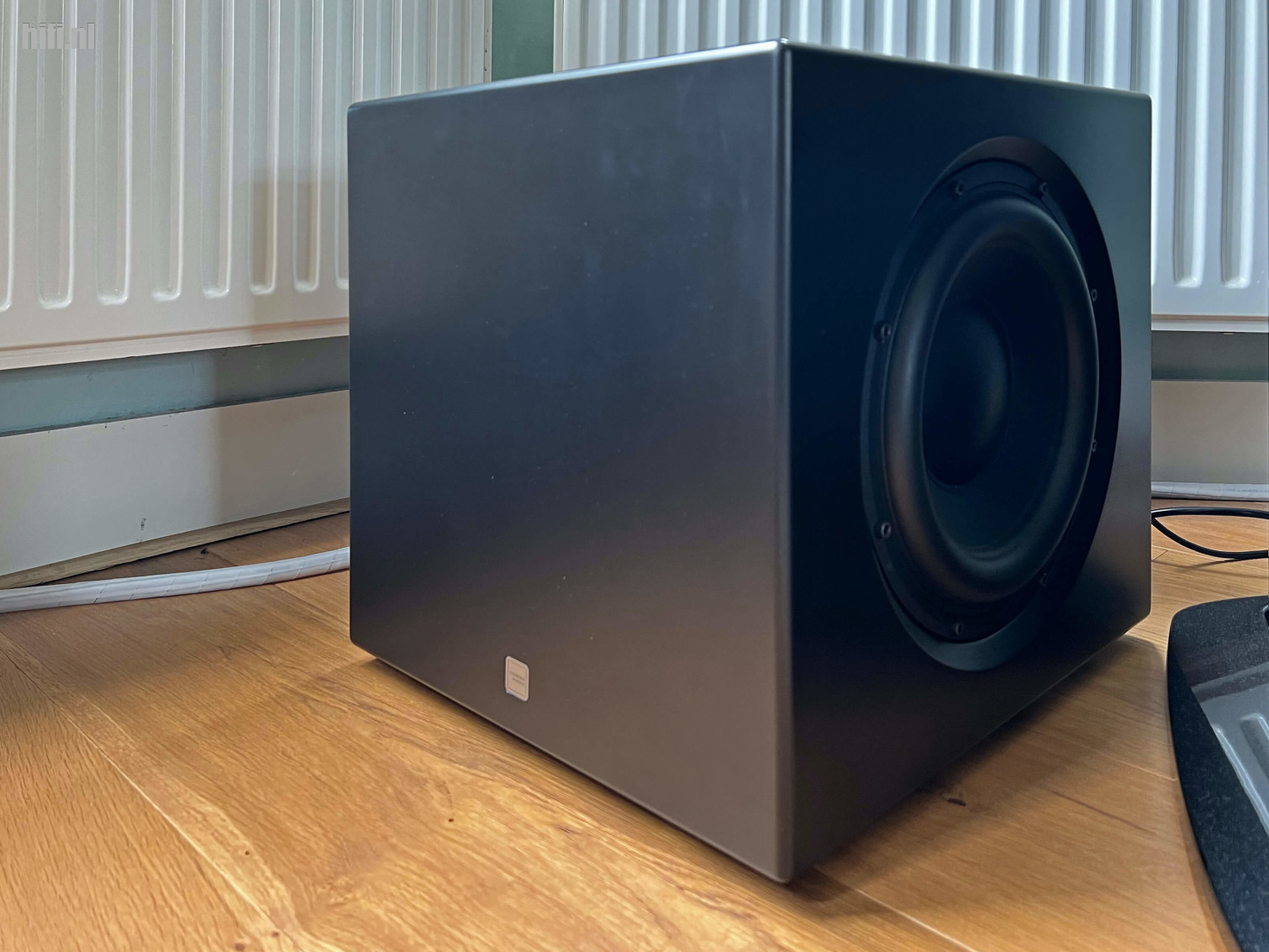
Next track is “Quadrophonia” from the album Cosmic Jam by the band Quadrophonia. This is something completely different from the last album choice. Immediately I am taken by the catchy ninety’s beats featuring alternating left-right stereo effects and periodic rap influences. Despite this piece of electronic music is fairly intensive by its nature, I pick out all the lines, instruments and effects effortlessly. I have experienced to this album fairly often on different sound systems. Today, for the first time in decades I got trapped by the immersive house party vibe again that I experienced while visiting obscure clubs so many years back in time. On “The Man with The Masterplan,” I am further drawn into this musical era with rap, synth effects and an impressive soundstage that is now stretched to full room width. I must say I feel truly blessed reviewing these incredible Manta’s.
I end the sessions with Enigma’s The Fall of The Rebel Angel. An excellent produced album featuring full-range soundscapes. With my eyes closed, this album fills all corners of the room with delicious music and stretches out to an imaginary horizon. The openness and precision with which the Mantas render this album is quite extraordinary. From the most powerful bass to delicately rendered details, effects and vocals. The entire tonal spectrum is presented to my ears with ease. This not only shows off the superb controlled amplification and phase behavior, it also indicates that the power supply for the amplification is designed very well. Even with violently powerful basses below 35 hertz, the remaining spectrum does not clog up and the soundstage isn’t pinched or limited in any way.
Verdict
These Manta’s including the 10D subwoofers from Sigberg Audio are impressive performers. Whether I play classical, rock, metal, dance or music of the electronica genre, this set of loudspeakers offer a most immersive sound experience. Thanks to the precision and nimbleness with which this active system plays my albums, you are treated with a maximum experience track after track. Thanks to the punch, slam and bass extension, live recordings feature an unmistakable live vibe. The neutral midrange has a fine texture to it without any of the typical harshness of previous generation Class D amplification. The heights are lively with a nice top end extension. Due to the use of silk-dome tweeters I never experienced any unexpected sharpness. Thanks to the excellent timing and phase behavior, every track I played I experienced a nearly perfect of phantom center where lifelike vocals are logically placed between the two loudspeakers. Depending on the album the singer sometimes takes a step into the background or forward to the listening position, but never ends up on your lap.
I couldn't be happier with Sigberg Audio’s Manta loudspeakers and 10D subwoofers offering a full-range experience. These loudspeakers are in financial reach of a larger group of music lovers and do outperform most similar priced conventional solutions. My experience with these Mantas can be best described as unforced, neutral and most precise to the ears. The sound spectrum is nicely balanced-out and voices have the correct weight to portray the artist in the room with realism.
This active Manta speaker duo performs at a level comparable to a conventional high-end setup that exceeds the investment of this Sigberg Audio Manta setup by a large amount. This active Manta system offers a level of sound quality that it will usually take years to accomplish with carefully mixing and matching various conventional hi-fi components, cables and loudspeakers. A most impressive accomplishment.
Conclusion
I have experienced these Mantas and 10D subwoofers from Sigberg Audio as well-voiced songbirds. The openness of the nCore modules allows me to experience delicate lines in music neatly separated in the soundstage. Nothing suggests I was listening to class D amplification, but rather to its solid-state class AB counterpart. The soundstage these speakers can project is nothing short of impressive. All played genres are provided with a width that is appropriate to the type of music. Never too narrow, pinched or overly wide. The most impressive thing is when I am off-center of the ideal listening position, I experience the same picture in a different perspective that never falls to pieces. This is really something special and underpins the added value of Sigberg Audio's cardioid concept. Highly recommended.
Sigberg Audio Manta (monitors) and 10D (subwoofer)
14.433 euro (monitors/pair) | 21.225 euro (including 2 subwoofers as recommended)
www.sigbergaudio.com | Rating combined system: 5 / 5

